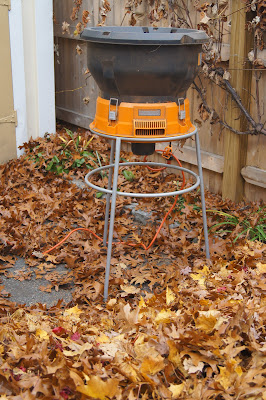What went well? A lot that wasn’t in my control. We got plenty of rain! That kept the garden lush and flourishing.
 |
| Rain made everything grow |
Also good was that the destructive nonnative winter moth dwindled my area. Tachinid flies (Cyzenis albicans) released by UMass professor Joe Elkinton are killing winter moth larvae. I counted three or four moths at the front porch lights this fall, nothing like the clouds of them we’ve seen in previous years. With so few parent moths, I predict few caterpillars will show up next spring to defoliate and weaken our trees.
 |
| There should be less winter moth damage next year |
Thanks to a much-abbreviated work schedule, I was in the garden most days all season. That gave me a chance to start addressing a list of dozens of tasks and projects I’d put off over the past decade.
This year I got to tear out a big patch of lawn and replace it with new perennials, mostly native species. It doesn’t look like much yet, with little plants surrounded by wide stretches of mulch. In three years when it’s filled in, I’m expecting a lush habitat for birds and native insects, as well as a pretty sight from the back of the house and the deck.
 |
| With luck, these little plants will grow wide and tall |
Restricting my container choices to neonicotinoid-free plants also turned out well, better than I’d expected. Maybe a smaller palette of choices prevented over-complicated compositions.
 |
| Simpler container combinations did better |
What didn’t go so well? Despite the plentiful rain, my vegetable garden didn’t produce a lot. Two problems stick out. First, I planted intensively with not much space between plants and rows because I’ve got so little sunny ground. That meant overcrowded plants didn’t get all the sun they needed. I didn’t leave enough space for paths, so while trying to spring lightly in and out of the beds, I stepped too close and packed down soil where roots were trying to grow.
 |
| Tight quarters in the vegetable garden |
This was the year I noticed my trees were crowded too, bent out of shape by competing to reach the light. That’s because of mistakes I made twenty years ago planting them too close together, like those vegetables. Having done that, I could have pruned more aggressively than I did. Back when the trees were young, I was afraid I’d kill them if I cut back their young branches to direct their growth. Now I know better.
 |
| Cramped trees |
The takeaway? Less is more. Make the hard choices and plant what I really have room for. Plan for the full-grown size, whether of 12-inch-tall bean plants or trees that will reach 60 feet. Failing that, don’t be too sentimental to thin out the extras when it’s time. Will I live by this insight and refrain from overcrowding the new perennial bed? Time will tell.















































